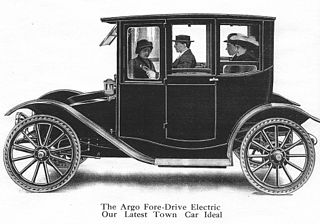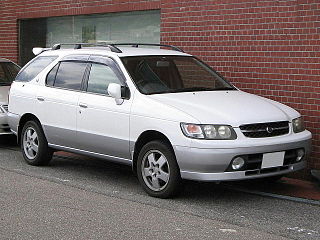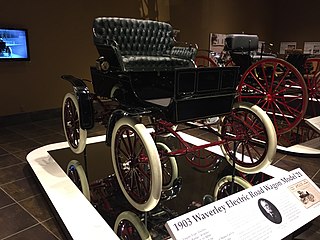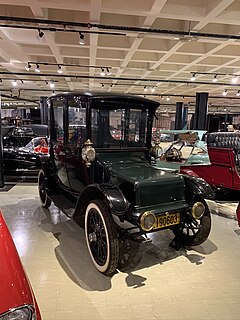 W
WElectric vehicles appeared in the mid-19th century. An electric vehicle held the vehicular land speed record until around 1900. The high cost, low top speed, and short range of battery electric vehicles, compared to 20th-century internal combustion engine vehicles, led to a worldwide decline in their use as private motor vehicles; although electric vehicles have continued to be used in the form of loading and freight equipment and public transport – especially rail vehicles.
 W
WThe AMC Amitron was an experimental electric subcompact car built in 1967 by American Motors Corporation (AMC) and Gulton Industries. It included many advanced features, including regenerative braking and advanced battery designs, to provide a 150-mile (240 km) range on a single charge. Development ended because of technology issues and the high cost of batteries.
 W
WThe AMC Concord is a compact car manufactured and marketed by the American Motors Corporation for model years 1978-1983. The Concord was essentially a revision of the AMC Hornet that was discontinued after 1977, but more luxurious, quieter, roomier, and smoother-riding than the series it replaced. It was offered in four-door sedan, two-door coupé, three-door hatchback, and five-door station wagon configurations. The Concord was AMC's volume seller from the time it appeared until the introduction of the Renault Alliance.
 W
WThe AMC Gremlin is a subcompact automobile introduced in 1970, manufactured and marketed in a single, two-door body style (1970–1978) by American Motors Corporation (AMC), as well as in Mexico (1974–1978) by AMC's Vehículos Automotores Mexicanos (VAM) subsidiary.
 W
WThe AMC Pacer is a two-door compact car produced in the United States by American Motors Corporation (AMC) from the 1975 to 1980 model years. The Pacer was also made in Mexico by Vehículos Automotores Mexicanos (VAM) from 1976 to 1979 and positioned as a premium-priced luxury car.
 W
WThe American Juvenile Electric was a car made by the American Metal Wheel & Auto Co of Toledo, Ohio, in 1907. Its wheelbase was a mere 3 feet 5 inches (1.04 m), but it was complete with ‘lights, bells, etc.’ and had tiller steering. Its top speed was 10 mph (16 km/h), and it could go 20 miles on a charge. At $800, it cost more than many full-size cars.
 W
WThe Argo Electric Vehicle Company was an electric automobile manufacturer that operated in Saginaw, Michigan, United States, from 1912 to 1916. The Argo Electric used a 60 volt system with Westinghouse motors. They claimed to be capable of 20 mph (32 km/h). It had 6 forward and 6 reverse speeds, had 36 x 4 cushion tires and used an 18-inch (457 mm) steering wheel on the left. They were offered in both four- and five-passenger models, with open and closed versions available, and all models used steering wheels. The 110-inch (2,794 mm) wheelbase was the longest of any electric at the time. The Argo Brougham was a 4-passenger car, weighing 3,200 lb (1,451 kg), claimed a range of 75 miles (121 km) per charge using thirty 190 ah, MV Exide batteries.
 W
WThe Babcock Electric Carriage Company was an early 20th-century United States automobile company, making electric vehicles under the Babcock brand from 1906 through 1912.
 W
WBaker Motor Vehicle Company was an American manufacturer of Brass Era electric automobiles in Cleveland, Ohio, from 1899 to 1914.
 W
WThe Buffalo Electric Vehicle Company was an American electric car manufacturing company from 1912 until 1915 located at 1219-1247 Main Street in Buffalo, New York. The motorcars were marked under the Buffalo brand. The company was formed by a merger of several electrical vehicle and allied companies which included:Babcock Electric Carriage Company Van Wagoner whose trucks were continued by the new company The Buffalo Automobile Station Company Buffalo Electric Carriage Company The Clark Motor Company
 W
WThe Bugatti Type 52 was a half-scale Bugatti Type 35 electric racing car for children. About 500 examples were produced,about 150 short nose and about 350 long nose ,they ware 10 cm longer to get elder children to use it at the Molsheim factory between 1927 and 1936, and the cars were frequently used both as playthings and for more serious racing among the children of the European elite. The number 52 was probably given by the late Hugh Conway and was never used by the factory. The factory always referred the car as Baby.
Columbia was an American brand of automobiles produced by a group of companies in the United States. They included the Pope Manufacturing Company of Hartford, Connecticut, the Electric Vehicle Company, and an entity of brief existence in 1899, the Columbia Automobile Company.
 W
WThe Detroit Electric was an electric car produced by the Anderson Electric Car Company in Detroit, Michigan. The company built 13,000 electric cars from 1907 to 1939.
 W
WThe electric fire engine is a fire engine with a water pump, used to distribute water to put out a fire, operated by an electric motor. Electric fire engines were first proposed in the 19th century to replace the steam pumpers used for firefighting. The electric motor was claimed to be simpler, cleaner, and faster in operation, would save money, and require less maintenance than the steam fire engine. Contemporary battery-operated models also exist.
 W
WThe Electrobat was one of the first electric automobiles. It was designed and built in 1894 by mechanical engineer Henry G. Morris and chemist Pedro G. Salom in Philadelphia, Pennsylvania. Both had backgrounds in battery streetcars and, as the battery streetcar business was fading, they teamed up to make battery road vehicles. Their effort was patented on August 31, 1894. Built like a small version of a battery streetcar, it was a slow, heavy, impractical vehicle with steel tires to support the 1,600 pound immense weight of its large lead battery. It entered production in 1895. In 1896, Morris and Salom founded the Morris & Salom Electric Carriage and Wagon Company, evidently the first electric car company in America.
 W
WThe Electrosport was a compact-sized electric vehicle based on the AMC Hornet that were converted by the Electric Fuel Propulsion Company (EFP) of Ferndale, Michigan.
 W
WThe Henney Kilowatt was an electric car introduced in the United States of America for the 1959 model year. The car used some body parts as made for the Renault Dauphine. An improved model was introduced in 1960 with a top speed of 60 miles an hour and a range of 60 miles. Only 47 cars were sold over the two model years, mostly to electrical utility companies. Only a few still exist.
 W
WThe Hupp-Yeats was an electric car. It was built in Detroit, Michigan, from 1911 to 1916. The parent company was begun by Robert Craig Hupp, previously of the Hupp Motor Company as the R.C.H. Corporation through 1912, later becoming the Hupp-Yeats Electric Car Company.
 W
WThe Jeep DJ is a two-wheel drive variant of the four-wheel drive CJ series. Production started in 1955 by Willys, which was renamed Kaiser Jeep in 1963. In 1970, American Motors Corporation (AMC) purchased Kaiser's money-losing Jeep operations and established AM General, a wholly owned subsidiary that built the DJ through 1984.
 W
WLa Jamais Contente was the first road vehicle to go over 100 kilometres per hour (62 mph). It was a Belgian electric vehicle with a light-alloy torpedo-shaped bodywork and batteries. The high position of the driver and the exposed chassis underneath spoiled much of the aerodynamics. The light alloy, called partinium, is an alloy of aluminium, tungsten and magnesium.
 W
WThe Nissan R'nessa is a station wagon manufactured by Nissan Motors from 1997 to 2001. According to Nissan, the name derives from "packaging renaissance for versatile, spacious comfort on wheels."
 W
WThe Owen Magnetic was a pioneering American brand of hybrid electric luxury automobile manufactured between 1915 and 1922. Car models of the brand were notable for their use of an electromagnetic transmission and were early examples of an electric series hybrid drivetrain. The manufacture of the car was sponsored by R.M. Owen & Company of New York, New York. The car was built in New York City in 1915, in Cleveland, Ohio, between 1916 and 1919 and finally in Wilkes-Barre, Pennsylvania, in 1920 and 1921. Body Style: 2-Door Electric Phaeton
 W
WThe Peugeot VLV was an electric microcar made by Peugeot in 1942. VLV stood for Voiture Légère de Ville. The car's announcement, on 1 May 1941, triggered some surprise, since Peugeot was the only one of France's large automakers to show interest in electric propulsion at this time.
 W
WPope-Waverley was one of the brands of the Pope Motor Car Company founded by Albert Augustus Pope and was a manufacturer of Brass Era electric automobiles in Indianapolis, Indiana. The company was originally formed as the Indiana Bicycle Company in 1898 changing to the American Bicycle Company in 1900. In 1903 it became the International Motor Car Company before joining the Pope group in 1903. From 1908 until production ceased in 1914 they became independent again as the Waverley Company.
 W
WThe Porsche P1, otherwise known as the Egger-Lohner electric vehicle, C.2 Phaeton model, is the first Porsche vehicle. It was designed by Ferdinand Porsche and is considered to be the first stepping stone for him before he and his son created the company, Porsche. The vehicle resembles a wooden crate or an old horse-drawn carriage but it is actually an electrically motored vehicle.
 W
WThe Rauch & Lang Carriage Company was an American electric automobile manufactured in Cleveland, Ohio, from 1905 to 1920 and Chicopee Falls, Massachusetts, from 1920-1932.
 W
WThe Riker was a veteran and brass era electric car founded in 1898 in Elizabeth, New Jersey.
 W
WSinclair Vehicles Ltd was a company formed in March 1983 by Sir Clive Sinclair as a focus for his work in the field of electric vehicles. The initial investment was £8.6m, which came from the proceeds of the sale of some of Sir Clive's shares in Sinclair Research. Barrie Wills, formerly of the DeLorean Motor Company, was appointed managing director.
 W
WSvensk Elektrobil AB (SEA) was a Swedish company that made electric vehicles. The Company was founded by Asea and was located at Rosenlundsgatan in southern Stockholm. The vehicle loaded 2.5 tonnes and had a top speed of 25 km/h.
 W
WWalker Electric Trucks were battery-powered vehicles built from 1907 to 1942 in Chicago, Illinois and Detroit, Michigan. Initially designed and manufactured by the Walker Vehicle Company in Chicago, they were bought by the Anderson Electric Car Company of Detroit in 1916, then sold to Commonwealth Edison of Chicago in 1920, and last to York & Towne in 1933. In addition to the trucks the company manufactured the Chicago Electric Car. Several of their trucks were long in service, surviving the brand, in some cases, by decades. A few of them are now on display in museums or, in the case of one exported to New Zealand, still "in service" with its original owner Orion New Zealand Limited.
 W
WWoods Motor Vehicle Company was an American manufacturer of electric automobiles in Chicago, Illinois, between 1899 and 1916. In 1915 they produced the Dual Power with both electric and internal combustion engines which continued until 1918.